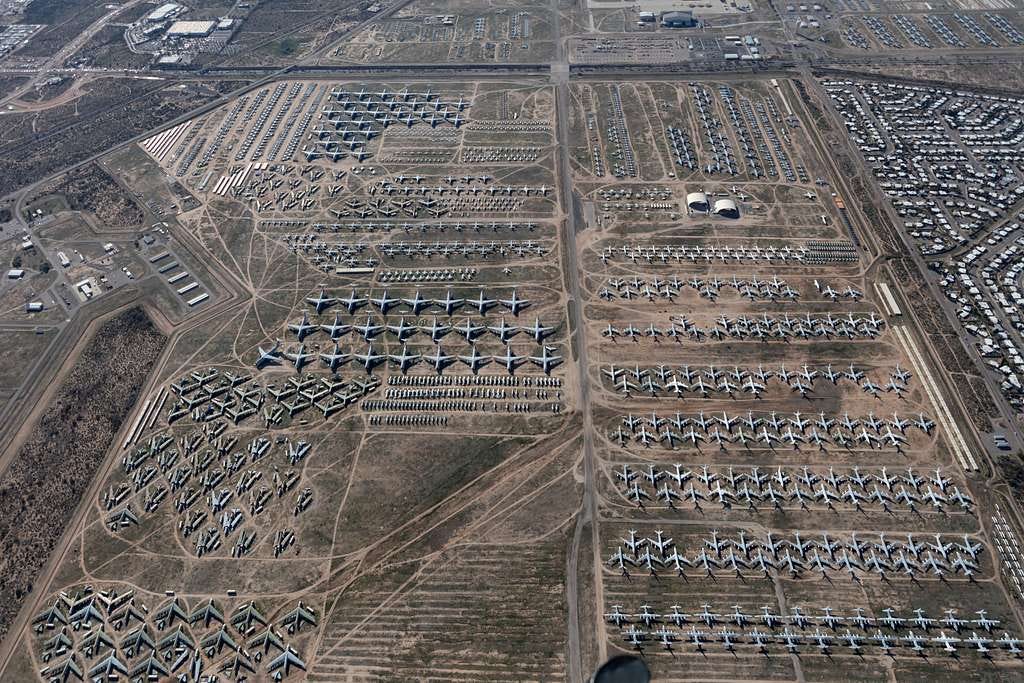Wings of the Past: Inside Arizona's Aircraft Boneyard
Where 4,000 Airplanes go to die. Silver sometimes recycled, but most is lost forever.
In the scorching heat of the Arizona desert, where cacti stand sentinel and mirages shimmer on the horizon, lies an unexpected treasure trove.
This isn't your typical silver mine, with deep shafts plunging into the Earth's crust. Instead, it's a vast expanse of asphalt, stretching as far as the eye can see, dotted with the gleaming silhouettes of retired aircraft.
Welcome to the 309th Aerospace Maintenance and Regeneration Group, affectionately known as "The Boneyard."
Here, amidst nearly 4,000 decommissioned planes, lies one of the world's most unconventional silver mines.
Each aircraft, from sleek fighters to hulking cargo planes, harbors approximately 2 kilograms of silver. This precious metal isn't visible to the naked eye, but it's there, hidden in switches, connectors, battery systems, and wires.
Some planes even boast silver plating on their surfaces, a testament to the metal's corrosion-resistant properties.
As the sun beats down on this metallic graveyard, a group of modern-day prospectors moves between the rows of silent giants. These aren't grizzled old men with pickaxes and pans, but skilled technicians armed with specialized tools and protective gear.
Their mission: to extract the silver from these mechanical behemoths.
The process is painstaking and precise. Each aircraft is systematically dismantled, its components carefully cataloged and sorted. The technicians work with the delicacy of surgeons, knowing that every gram of silver recovered contributes to this unusual mining operation.
In the distance, a team celebrates as they extract a particularly large cache of silver from an old military transport plane.
The excitement is palpable; it's akin to striking a rich vein in a traditional mine.
As day turns to dusk, the setting sun casts long shadows across the Boneyard. The aircraft, once symbols of human achievement and military might, now serve a different purpose. They've become a vital source of precious metals, their silver content more valuable than ever in an age of increasing technological demand.
The irony isn't lost on the workers. These planes, designed to soar through the skies, now contribute to the Earth's resources in their final resting place. It's a poetic cycle of creation, use, and reclamation. Nearby, in a makeshift refinery, the day's haul is being processed.
The extracted silver is melted down, purified, and formed into ingots. These shining bars of metal, born from the remnants of aviation history, will soon find new life in cutting-edge technologies.
As night falls, the Boneyard takes on an almost ethereal quality. Moonlight glints off the metallic surfaces of the planes, creating an otherworldly landscape. It's easy to imagine that somewhere beneath this sea of aluminum and steel, veins of silver run like rivers, waiting to be tapped.
This unconventional mine serves as a testament to human ingenuity and the circular nature of resources. It's a place where the past quite literally fuels the future, where decommissioned aircraft become the raw materials for tomorrow's innovations.
As the world grapples with resource scarcity and environmental concerns, the Boneyard stands as a shining example of creative recycling on a massive scale. It's not just a graveyard for planes; it's a birthplace for new possibilities, a silver lining in the world of aerospace retirement.
In the cool desert night, the Boneyard sleeps, its treasures waiting to be uncovered with the dawn.
Tomorrow, the modern-day miners will return, ready to extract more silver from this most unusual of mines, proving that sometimes, the most valuable resources are hiding in plain sight, right here on the asphalt plains of Arizona.
The human interest story has a serious tone. This is a shocking example of Government waste.
Remember that our GDP counts military spending and military employment.
Here is a fitting analogy. If the US decided to dig 1 billion holes one week, then cover up those 1 billion holes the following week (both the digging exercise and the refilling exercise would count in the GDP)
end of section
In stark contrast to the Silver Deposits found in Arizona in the human interest story above, let’s pivot and take a serious look at one of the World’s Most Robust Silver Deposits.
5 Reasons We Endorsed Aya Gold and Silver
Why Aya Gold and Silver? Why Morocco?
Because it offers a unique silver investment opportunity that stands out from the rest.
Pure Silver play: so you are not paying for Silver as a by-product to copper, lead or zinc (which leads to being exposed to numerous other contingency risks)
Among the lowest all-in-sustaining costs Worldwide, your investment is set to yield promising returns.
With a management team that is experienced and duplicates their past success, your investment is in safe hands.
Decades of resources are still left to mine.
Check out their Q2 results. Mr. Market still hasn’t priced all this in the cake yet.
Aya Gold and Silver CEO Benoit La Salle





